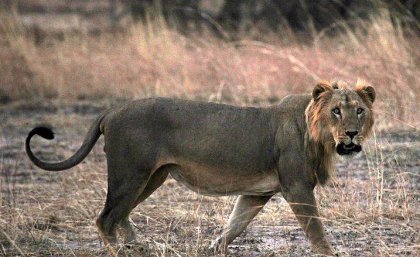
The African lion faces extinction across the entire West African region, according to a new report.
Lions once ranged continuously from Senegal to Nigeria, but the new paper – co-authored by a University of Queensland researcher – reveals only about 250 adult lions survive in the region.
Only one of the four isolated and severely imperiled populations contains more than 50 lions.
After a six-year survey covering 11 countries where lions were presumed to exist in the past two decades, the paper The Lion in West Africa is Critically Endangered has been published in the scientific journal PLOS ONE.
The research was led by Dr Philipp Henschel, the survey co-ordinator of international conservation group Panthera. A team from West Africa, Australia, the UK, Canada and the United States co-authored the paper.
“When we set out in 2006 to survey all the lions of West Africa, the best reports suggested they survived in 21 protected areas,” Dr Henschel said.
“We surveyed all of them, representing the best remaining lion habitat in West Africa.
“Our results came as a complete shock. All but a few of the areas we surveyed were basically paper parks, having neither management budgets nor patrol staff, and had lost all their lions and other iconic large mammals.”
The team discovered that West African lions now survive in only five countries, Senegal, Nigeria and a single trans-frontier population on the shared borders of Benin, Niger and Burkina Faso.
They are genetically distinct from the better-known lions of famous game parks in East and southern Africa.
Recent molecular research shows they are closely related to the extinct “Barbary Lions” which once roamed North Africa, as well as to the last Asiatic lions surviving in India.
Co-author Dr Lauren Coad, research fellow at The University of Queensland and University of Oxford, said West Africa’s protected areas needed international funding and support.
“Our findings suggest that many of the West African protected areas still supporting lion populations are chronically underfunded and understaffed,” Dr Coad said.
“Many protected areas evaluated for this study did not have the capacity to undertake anti-poaching patrols, and as a result lion populations within their boundaries are under threat from poachers, who target both lions and their prey.”
Dr Christine Breitenmoser, the co-chair of the IUCN/SCC Cat Specialist Group which determines the conservation status of wild cats around the world, said West African lions had unique genetic sequences.
“These genes are not found in any other lions, including in zoos or captivity,” she said.
“If we lose the lion in West Africa, we will lose a unique, locally adapted population found nowhere else. It makes their conservation even more urgent.”
Lions have disappeared across Africa as human populations and their livestock herds have grown, competing for land with lions and other wildlife.
As wild savannas are converted for agriculture and cattle, the lion’s natural prey is hunted out and lions killed by pastoralists fearing the loss of their herds.
Dereck Joubert of National Geographic’s Big Cats Initiative, which provided funding for the survey, said big cat surveys were notoriously inaccurate.
“As soon as you do it, it is dated – the declines are so rapid,” Mr Joubert said.
“It’s a terribly sad state of affairs when you can very accurately count the lions in an area because there are so few.
“This is critical work that confirms, scientifically, once again that we are underestimating the rate of decline and will require a global emergency intervention.”
Panthera says that fewer than 35,000 lions remain in Africa today, in about 25 per cent of the species’ original range.
In West Africa, the lion now survives in less than 50,000km2 – smaller than half the size of New York State – and only one per cent of its original historic range in the region.
Panthera President Luke Hunter, one of the paper’s co-authors, said lion populations had undergone “a catastrophic collapse” in West Africa.
“The countries that have managed to retain them are struggling with pervasive poverty and very little funding for conservation,” he said.
“To save the lion – and many other critically endangered mammals including unique populations of cheetahs, African wild dogs and elephants – will require a massive commitment of resources from the international community.”
Panthera is working to protect and grow Africa’s remaining lion populations through Project Leonardo.
Contact: Dr Lauren Coad, UQ Visiting Fellow 2013, UQ School of Geography, Planning and Environmental Management, lauren.coad@ouce.ox.ac.uk,
Environmental Change Institute, University of Oxford, UK.
http://oxford.academia.edu/LaurenCoad
http://www.eci.ox.ac.uk/people/coadlauren.php
About Panthera
Panthera, founded in 2006, is devoted exclusively to the conservation of wild cats and their ecosystems. Utilising the expertise of the world’s premier cat biologists, Panthera develops and implements global conservation strategies for the largest, most imperiled cats – tigers, lions, jaguars, and snow leopards. Representing the most comprehensive effort of its kind, Panthera works in partnership with local and international non-government organisations, scientific institutions, local communities and governments around the globe.


